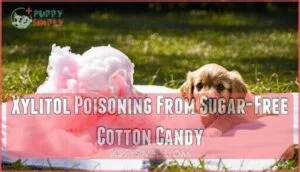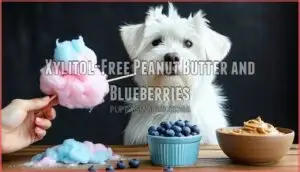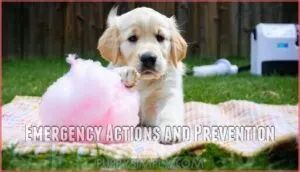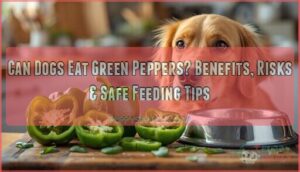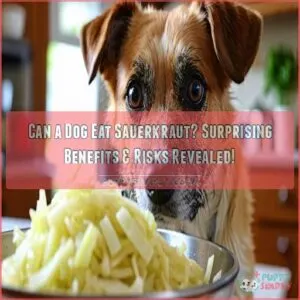This site is supported by our readers. We may earn a commission, at no cost to you, if you purchase through links.

Cotton candy is all sugar, which can send your pup’s blood sugar on a wild rollercoaster. Add in artificial colors, flavors, or even hidden dangers like xylitol or chocolate, and you’ve got a recipe for trouble.
Even a small bite can upset their stomach or lead to tooth decay. Think of it as a treat meant for humans, not hounds.
If your dog snags some, keep an eye out for odd behavior and call your vet. There’s more to keeping your dog safe than meets the eye, including being aware of potential dangers like chocolate.
Table Of Contents
- Key Takeaways
- Cotton Candy Composition
- Can Dogs Eat Cotton Candy
- Health Risks for Dogs
- Safe Alternatives for Dogs
- Emergency Actions and Prevention
- Frequently Asked Questions (FAQs)
- What happens if a dog eats cotton candy?
- Can dogs eat chocolate?
- Can dogs eat cotton?
- Can dogs eat cotton candy ice cream?
- Can dogs eat cotton candy grapes?
- Can dogs eat cotton balls?
- What will happen if a dog eats cotton candy?
- Are dogs allowed cotton candy?
- Can dogs have pink cotton candy?
- Is it okay for dogs to eat cotton?
- Conclusion
Key Takeaways
- Don’t let your dog eat cotton candy—it’s pure sugar with no nutritional value and can upset their stomach.
- Watch out for hidden dangers like xylitol and chocolate in cotton candy, as both are toxic to dogs.
- Even a small bite can cause blood sugar spikes, digestive issues, or dental problems for your pup.
- Stick to safe treats like cooked veggies, fruits (not grapes), or dog-specific snacks instead.
Cotton Candy Composition
When you look at cotton candy, you’ll see it’s mostly spun sugar with added colors and flavors, and sometimes even artificial sweeteners or chocolate.
Knowing exactly what’s inside helps you understand why it’s not a safe treat for your dog.
Sugar and Coloring Content
When you look at cotton candy, you’re really seeing a cloud of sugar and artificial colors.
It’s almost all sugar, with little to no nutritional value for dogs. The bright hues come from artificial additives, which can cause issues for some pets.
Many candies contain xylitol, a dangerous sweetener, that owners should be aware of.
Watch out for:
- High Calorie Content
- Nutritional Absence
- Potential Coloring Effects on dog sugar intake
Artificial Sweeteners and Flavorings
Spotting artificial sweeteners and flavors in cotton candy is essential for dog owners.
Xylitol Toxicity tops the list of Sweetener Dangers—just a nibble can be life-threatening for dogs.
Artificial sweeteners, chemical additives, and artificial flavors pose serious dog health risks.
Always practice Label Reading to avoid hidden toxicity.
Remember, artificial sweeteners and dog dietary concerns don’t mix, as Xylitol Toxicity is a significant threat.
Refined White Sugar as Primary Ingredient
In the case of cotton candy, refined white sugar is the main player.
Sugar processing strips away nutrients, leaving only empty calories.
For dogs, sugar triggers a sharp insulin response, affecting metabolic effects and overall dog health.
Regular sugar intake raises dog dietary concerns—think dental impact, obesity, and even toxicity.
Dogs and sugar just don’t mix well for long-term health.
Potential Presence of Chocolate and Theobromine
You’re aware that refined white sugar is the primary ingredient, but beware: some cotton candy contains chocolate with theobromine, toxic for dogs.
Ingesting chocolate can lead to chocolate toxicosis in dogs.
Key concerns include:
- Theobromine toxicity
- Chocolate dangers
- Heart failure
- Digestive issues
- Lethal dosage
Can Dogs Eat Cotton Candy
You’re likely wondering if your furry friend can indulge in cotton candy. Unfortunately, the answer is a resounding no.
Cotton candy is basically pure sugar, which can lead to sugar overload and behavioral changes in dogs. The long-term effects of consuming such high-sugar treats can be detrimental to your dog’s health.
As a responsible pet owner, it’s vital to prioritize pet safety and avoid giving your dog cotton candy, as it’s toxic for dogs due to its sugar content and potential artificial additives. This is one dog health question with a clear answer: keep cotton candy away.
Similarly, it’s also worth mentioning that xylitol can be dangerous for dogs, so avoid sugar-free candies as well.
Health Risks for Dogs
You’re likely aware that cotton candy is bad for your dog, but you may not know the full extent of the health risks.
As you consider giving your dog a sweet treat, it’s vital to understand that cotton candy can lead to blood sugar imbalances, stomach upset, and other serious health issues for your pet.
Blood Sugar Level Imbalances
After learning if dogs can have cotton candy, let’s talk sugar rollercoasters. Feeding your pup sugar may cause blood sugar level imbalances, bringing problems like insulin resistance and metabolic disruption.
Here are real risks:
- Hormonal effects worsen diabetes
- Appetite changes confuse meal routines
- Sudden hypoglycemia
- Dangerous seizure risk
- Overall loss of energy and mood
Stomach Upset and Digestive Issues
Ever watched your dog eat cotton candy and wondered what could go wrong?
Sugar overload can hit their tummy hard, causing stomach upset, diarrhea potential, or even vomiting risks.
In more serious cases, the pancreatitis threat or liver disease can appear.
Addressing gastrointestinal concerns early can prevent more severe complications.
Cotton candy isn’t just a sweet treat—it’s a recipe for uncomfortable days spent cleaning up after your pup.
Dental Problems and Tooth Decay
Regarding your dog’s dental health, cotton candy is a recipe for disaster.
Here are 5 reasons why:
- Sugars impact your dog’s teeth, leading to tartar buildup and gum disease.
- Regular consumption can cause bad breath and painful dental issues.
- Preventative care is key to avoiding these problems.
- Limit sugary treats like cotton candy to protect your dog’s dental health.
- Regular check-ups with your vet can help identify potential issues early on.
Toxic Poisoning From Chocolate-Flavored Cotton Candy
Feeding dogs chocolate-flavored cotton candy poses a significant risk due to Theobromine Toxicity, which can cause Seizure Risk, Heart Failure, and even Fatal Dosage.
Prompt Veterinary Intervention is vital to prevent toxic poisoning from chocolate and other toxic foods containing theobromine.
This is because chocolate contains theobromine and caffeine, which are toxic to dogs.
Xylitol Poisoning From Sugar-Free Cotton Candy
Xylitol is sneaky trouble for dogs—popping up in sugar-free cotton candy as a hidden danger.
Even a nibble can trigger xylitol toxicity: a wild insulin surge, shaky blood sugar, and quick-onset liver failure.
Hidden sweeteners in "sugar-free" treats can be deadlier than regular sugar for dogs.
Seizure risk is real, and only fast veterinary intervention can save the day.
Bottom line: artificial sweeteners, especially xylitol, are toxic foods that should never enter your dog’s snack rotation.
Safe Alternatives for Dogs
If your dog’s sweet tooth is begging for a treat, you’ve got plenty of safe, tasty options to choose from.
Skip the cotton candy and offer your pup healthy snacks like cooked vegetables, natural fruits, or specially formulated dog treats instead.
Low-Sugar Treats With Natural Ingredients
After exploring the health risks of cotton candy for dogs, let’s talk better options. Keep your canine happy with low-sugar treats made from natural ingredients.
Skip the candy aisle and try these instead:
- Homemade dog treats with safe sweeteners
- Vegetable-based snacks (no onions or garlic)
- Fruit-based snacks (hold the grapes)
- Protein-rich options for energy
- Safe dog treats from trusted brands
Consider purchasing low sugar options online for a healthy alternative.
Homemade Options Like Cooked Vegetables and Fruits
Making your own dog treats saves money and gives you complete control over ingredients.
You can prepare cooked vegetables like carrots, sweet potatoes, and green beans, which provide essential vitamins and fiber.
Fresh fruits such as watermelon and blueberries offer natural sweetness without harmful additives.
Some owners even seek specialty dog products for their pets.
Always practice portion control when introducing new safe foods for dogs to maintain proper dietary balance and ensure the well-being of your pet with complete control.
Commercial Dog Treats With Healthy Ingredients
Commercial dog treats designed specifically for canine nutrition offer safer alternatives than cotton candy.
Look for brands with transparent ingredient sourcing and clear nutritional information. Quality treats focus on treat nutrition with natural proteins and limited additives.
Consider exploring the benefits of buying dog treats for your pet. Practice portion control based on your dog’s size and dietary needs.
Compare brands for allergen awareness, especially if your pet has sensitivities. Well-formulated commercial options support overall dog health concerns better than sugary human snacks.
Xylitol-Free Peanut Butter and Blueberries
Peanut butter offers excellent nutritional benefits for dogs when it’s xylitol-free. Always check labels carefully since xylitol poses serious health risks.
Blueberries provide antioxidants and vitamins while satisfying your dog’s sweet tooth safely. For serving sizes, offer one tablespoon of peanut butter per 20 pounds of body weight.
Consider allergy concerns before introducing new foods into your pet’s diet.
Emergency Actions and Prevention
If your dog accidentally eats cotton candy, watch for symptoms like vomiting, diarrhea, excessive thirst, or lethargy and contact your vet immediately if any appear.
Quick action saves lives—watch for vomiting, diarrhea, and lethargy after cotton candy accidents.
Prevention is key—keep all sugary treats stored safely away from curious paws and teach everyone in your household why dogs can’t share our sweet snacks.
Monitoring for Symptoms After Accidental Ingestion
If your dog ate sugar or got into cotton candy, don’t panic, but keep your eyes peeled for vomiting or diarrhea, sudden lethargy signs, or a sugar rush.
Notice any drooling, appetite changes, or dehydration (skin tenting, dry gums).
Seizure watch is serious—shaking or loss of balance needs urgent attention.
Be vigilant for changes like labored or rapid breathing, which can indicate a serious problem.
Monitor dog behavior closely and act fast if symptoms appear.
Consulting a Veterinarian for Personalized Advice
Your veterinarian understands your dog’s dietary needs, breed specifics, and health history better than anyone.
They’ll provide personalized vet advice dogs need, especially regarding canine dietary restrictions and safe treat options.
Emergency protocols vary by situation, so having veterinary advice suited to your pet’s unique circumstances guarantees you’re prepared when accidents happen, and this is crucial for emergency protocols.
Keeping Sugary Foods Out of Reach
Smart storage prevents cotton candy disasters.
Keep sugary treats in high cabinets with child-proof locks for secure storage.
Choose airtight containers your dog can’t open through clever paws or persistence.
Height placement matters—counter-surfing dogs need treats stored well above their reach.
Guest awareness helps too, since visitors might accidentally drop cotton candy.
These container choices and storage strategies protect your pup from harmful foods for dogs while supporting proper dog nutrition tips and reducing dog health risks.
Educating Household Members About Dangers of Sugary Treats
Everyone in your household needs to understand why cotton candy and other sugary treats pose serious health risks to dogs.
Family Education starts with explaining how sugar affects your pet’s body differently than humans.
Clear, Consistent Rules help prevent accidental feeding incidents when guests visit.
- Kids learning why sharing their carnival treats isn’t actually showing love to the dog
- Grandparents understanding that "just a little bite" can trigger dangerous blood sugar spikes
- Houseguests knowing which Treat Alternatives are safe before they arrive with good intentions
Scheduling Regular Veterinary Check-Ups for Overall Health
Regular check-ups help your veterinarian catch health issues before they become serious problems.
These visits allow for early detection of conditions that sugary treats might worsen.
Your vet can provide personalized dog care tips and monitor your pet’s overall wellness.
| Preventative Care Focus | Recommended Frequency |
|---|---|
| Wellness Exams | Every 6-12 months |
| Vaccination Schedules | Annual or as advised |
| Parasite Control | Monthly treatments |
| Dental Health Checks | Every 6 months |
| Weight Monitoring | Each visit |
Pet health discussions give you direct vet advice dogs need for ideal care.
Frequently Asked Questions (FAQs)
What happens if a dog eats cotton candy?
Like a sugar tornado, cotton candy can send your dog’s system spinning—expect upset stomach, vomiting, or diarrhea.
If it’s sugar-free or chocolate-flavored, rush to the vet, since xylitol or theobromine are dangerous.
Can dogs eat chocolate?
You shouldn’t let your dog eat chocolate.
Even a small amount can cause vomiting, diarrhea, or seizures.
Chocolate contains theobromine, which dogs can’t process well.
It’s best to keep all chocolate out of paw’s reach.
Can dogs eat cotton?
You shouldn’t let your dog eat cotton.
It can’t be digested and could cause a blockage in their stomach or intestines.
If your pup swallows cotton, call your vet—better safe than sorry!
Can dogs eat cotton candy ice cream?
You shouldn’t share cotton candy ice cream with your dog.
It’s packed with sugar, artificial flavors, and possibly xylitol, which is toxic.
Even a few licks can upset their stomach or cause serious health problems.
Can dogs eat cotton candy grapes?
Cotton candy grapes might sound fun, but they’re just sweet grapes bred to taste like candy.
Dogs can eat a few plain grapes, right?
Actually, no—grapes are toxic to dogs and can cause kidney failure.
Avoid them entirely.
Can dogs eat cotton balls?
You shouldn’t let your dog eat cotton balls.
They can’t digest them, so swallowing even one could cause choking or a blockage in their stomach or intestines.
If your pup grabs one, call your vet right away.
What will happen if a dog eats cotton candy?
Imagine your pup sneaking a bite at the fair—suddenly, you’re on stomach-watch.
Eating cotton candy can cause vomiting, diarrhea, hyperactivity, or worse if it contains xylitol or chocolate.
Call your vet if symptoms appear.
Are dogs allowed cotton candy?
You shouldn’t give dogs cotton candy.
It’s packed with sugar and sometimes contains xylitol or chocolate, both dangerous for pups.
Even a small bite can upset their stomach or worse—send you both on an emergency vet visit to address the dangerous consequences.
Can dogs have pink cotton candy?
Like a wolf in sheep’s clothing, pink cotton candy looks harmless but packs a sugary punch.
Don’t let the color fool you—dogs shouldn’t eat it.
The sugar and artificial dyes can upset their stomach and cause bigger health issues.
Is it okay for dogs to eat cotton?
You shouldn’t let your dog eat cotton.
Dogs can’t digest it, and swallowing cotton can cause dangerous blockages in their stomach or intestines.
If your pup snacks on cotton, call your vet right away for advice.
Conclusion
Did you know that over 50% of dogs will eat anything left within their reach?
That’s why it’s so important to ask, can dogs eat cotton candy? The answer’s clear—cotton candy isn’t safe for your dog.
Its sugar, artificial colors, and hidden toxins pose real risks, from upset stomachs to dangerous poisoning.
Stick to dog-friendly treats instead. By keeping cotton candy out of paw’s reach, you’re protecting your furry friend’s health and happiness every day.





